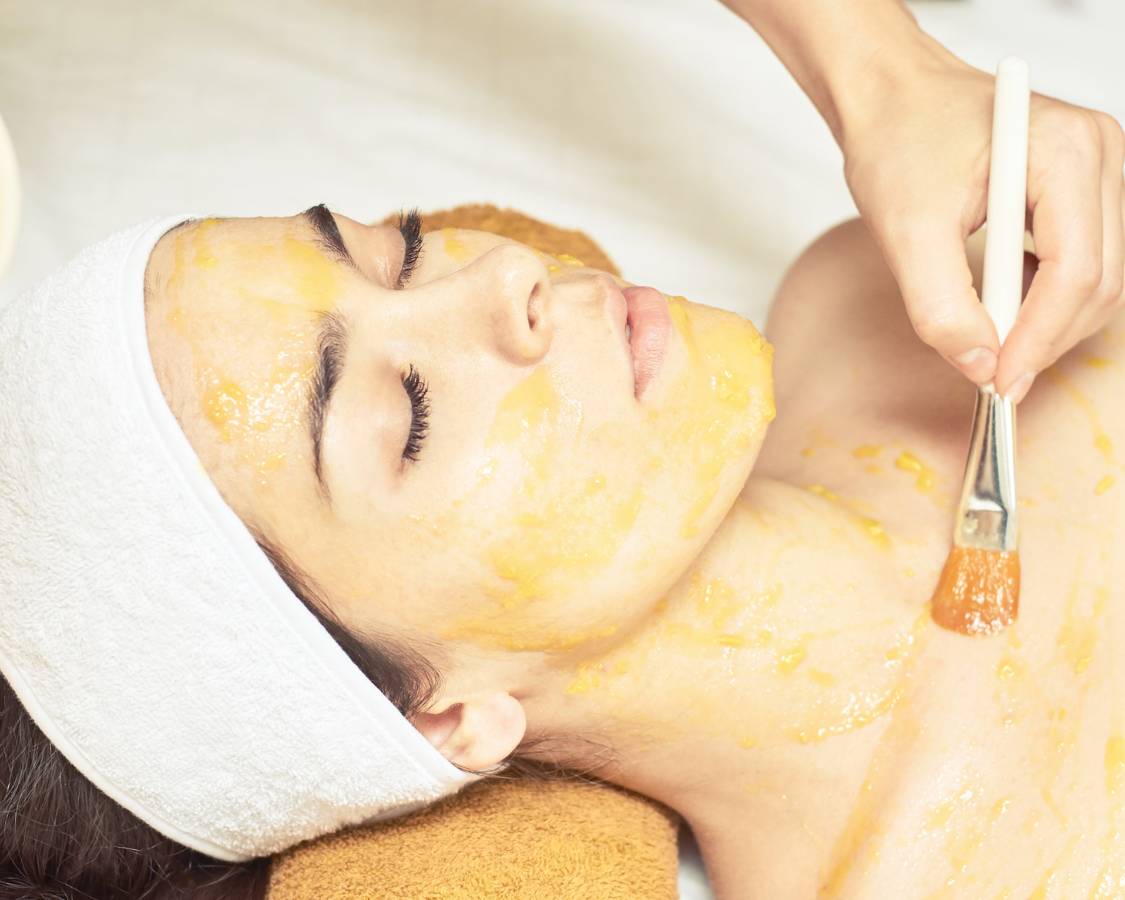A chemical peel is a skincare treatment that is used to reduce the visible signs of aging, such as wrinkles, sun spots, acne scars, and even skin pigmentation. The peeling agent employed in the chemical peel typically contains compounds such as glycolic acid, trichloroacetic acid, lactic acid, or a combination of these and other substances. The chemical solution is applied directly to the skin and left on for several minutes; this allows the peel to penetrate deep into the surface.
When the time has elapsed, the outer layers of the skin are peeled away, revealing a smoother, fresher layer of skin. The new skin is also much more resilient and firm, allowing it to more quickly absorb creams and serums. Finally, the fresh, new skin is more resistant to environmental damage, including aging and sun damage.
Chemical peels are suitable for almost anyone who has visible signs of aging, such as wrinkles, age spots, and sun damage. The procedure is especially effective for reducing the appearance of lines and wrinkles around the eyes and mouth. It can also be used to reduce the appearance of damage caused by acne, smoking, or simply the aging process itself. For best results, Dr. Rishi recommends that a board certified doctor or licensed aesthetician assists with the application of chemical peels.
Chemical peels can treat a variety of skin concerns that include but are not limited to:

Though there are several agents available, mainly one of the following will be used at Parashar Skin Clinic, New Delhi.
Alpha Hydroxy Acids, also known as AHA’s are actually fruit acids. Amongst AHA’s Glycolic acid is the most commonly used.
Glycolic acid is the gold standard in chemical peel formulations. Its exfoliation properties work wonders on the patient’s skin. Glycolic peel is tremendously useful for its proven ability to transform the health and appearance of a multitude of skin types.
It is mainly used to treat:
In Beta Hydroxy Acids or BHA’s, salicylic acid is the most commonly used agent. The use remains more or less the same as alpha hydroxy acids but gives excellent results for acne and acne scars.
Phenol peels are actually quite strong and work excellently at the deeper levels of the skin. Although chemical peels generally do not require anesthesia, due to its strong properties and deep penetration, phenol does require anesthesia. Due to its nature, it is generally inadvisable for individuals with dark or deep skin tone people as it might result in bad scarring and pigmentation changes.
Peels are then classified according to the issues targeted. They are as follows:
It targets current breakouts and past marks as well as prevents future breakouts. It uses cleansing by antimicrobials followed by skin treatment with anti-acne medicines like BHA. It is followed by therapy to improve the hydration of the skin. A soothing mask is applied at the end.
This targets the uneven complexion that is a result of prolonged sun exposure. A preliminary cleansing is followed by AHA peel. A soothing mask is applied at the end.
It takes care of fine wrinkles and provides fresh glowing younger looking skin. After cleansing, the skin is treated with mild AHA. This will lead to an invisible peeling effect. A soothing mask at the end helps to control any discomfort which might occur.
As the name suggests, it is for regular skin management. The skin is cleansed and treated with polishing. The treatment is followed by Vitamin C therapy which improves glow and clears complexion irregularities.
Advanced skin peeling takes care of wrinkles, dullness, complexion irregularities, and skin laxity. Skin will be glowing, uniformly fair, tight, and free from fine wrinkles.
The chemical peeling process begins with an evaluation of the overall skin health and the areas of concern. This evaluation is important to ensure that the chemical peel is the right choice for achieving the desired outcome.
When you visit the Houston Cardiology clinic, Dr. Rishi and his team will ensure that your skin is prepared to receive the chemical peel. After the skin has been cleaned, a medical-grade chemical is applied topically, and may be left on for anywhere between 5 to 15 minutes. During this time the solution will penetrate beneath the surface layers of the skin; thus, exfoliating the damaged skin cells. After the time has elapsed, the doctor will rinse the area to remove the peel from the skin, and may apply serums, lotions, or sunscreen in the treated area.
The duration of the treatment typically depends on the type of chemical peel chosen, and the sensitivity of the patient’s skin.
Chemical peels are generally safe, but they too can have side effects, including redness, peeling, itching, swelling, and blistering. Temporary symptoms such as redness are normal and typically subside within a few days of the treatment.
However, it is important to note that some people may have a sensitivity to the chemicals used in chemical peels, and may experience adverse effects, such as changes in skin tone or scarring. Therefore, it is important to share your concerns with the doctor, so that he/she can help you assess the pros and cons for your individual situation before proceeding with the chemical peel.
In terms of benefits, patients can expect a reduction in wrinkles, acne scars, age spots, and other blemishes; in addition to a fresher, more youthful skin, and an overall improvement in skin tone and texture.
The results will be visible fairly quickly. Areas affected by acne scars, wrinkles, or sun spots, may require several sessions before the desired improvement is achieved. Sun-damaged skin requires several treatments to achieve the desired result.
The results of chemical peels generally last for about two to three months, and can often be enhanced with a maintenance peel two or three times a year. While many patients do not require any downtime, certain treatments may involve some redness and peeling. However, the downtime depends on the strength of the chemical peel and the skin of the patient.
Chemical peels offer a number of advantages over other skin rejuvenation treatments. Unlike laser treatments, which target specific areas of the skin, a chemical peel offers comprehensive skin rejuvenation. In addition, chemical peels provide a more cost-effective solution that can address a number of skin concerns simultaneously.
Chemical peels can also be used in conjunction with other treatments, such as microdermabrasion or laser skin resurfacing, to achieve an even more effective result. Moreover, the downtime associated with chemical peels is usually shorter than with other skin rejuvenation treatments.
Before receiving a chemical peel, it is important to notify the doctor of any products or medications that you’re taking. The doctor may also advise you to avoid using certain creams, lotions, or makeup, as these may interfere with the effectiveness of the peel.
For best results, Dr. Rishi recommends that any skincare, sunscreens, and makeup you use contain only natural and organic ingredients. Once the chemical peel has been applied, the patient should avoid exposing the area to sunlight until the skin has fully healed. Additionally, the patient should refrain from exfoliating, scrubbing, or applying harsh products to the area.
Proper chemical peel aftercare is key to maintaining optimal results. After the chemical peel, the doctor typically recommends leaving the skin alone for a few days. During this period, the skin may be slightly red and swollen. The doctor may then recommend a post-treatment cream or moisturizer to help soothe the skin.
Furthermore, it is important to protect the skin from the sun. Too much sun can cause the results to fade more quickly, so the doctor typically recommends using a broad-spectrum sunscreen with an SPF of at least 30 every day. It is also important to use gentle products, such as cleansers and moisturizers that are specifically designed for post-peel care.
Overall, chemical peels provide an effective and fast way to improve the look and feel of the skin. With proper care and maintenance, you can ensure that you get the most out of your treatment and maintain your results for a long time.

If you’re considering getting a chemical peel, Dr. Rishi and his team at Parashar Skin Clinic are here to help. Our experienced team of skin care experts are dedicated to helping you get the best results for your skin, no matter your skin care needs. Contact Parashar Skin Clinic in New Delhi today for a free consultation and discover how a chemical peel can transform your skin and restore your beautiful, natural look.
Book Appointment

MBBS, MD Dermatology
Dr. Rishi Parashar is a distinguished dermatologist with an impressive academic background and 25 years of experience in the field. He earned his MBBS degree from SMS Medical College, Jaipur, affiliated with the University of Rajasthan, in 1994.
His relentless pursuit of knowledge led him to achieve an MD in Dermatology from Kasturba Medical College, Manipal, in 1998. With his vast experience, Dr. Parashar combines his extensive education with a passion for dermatology to provide top-notch care to his patients.
Additionally, he holds the esteemed position of Co-chairman in the Department of Dermatology at Delhi's prestigious Sir Gangaram Hospital.
